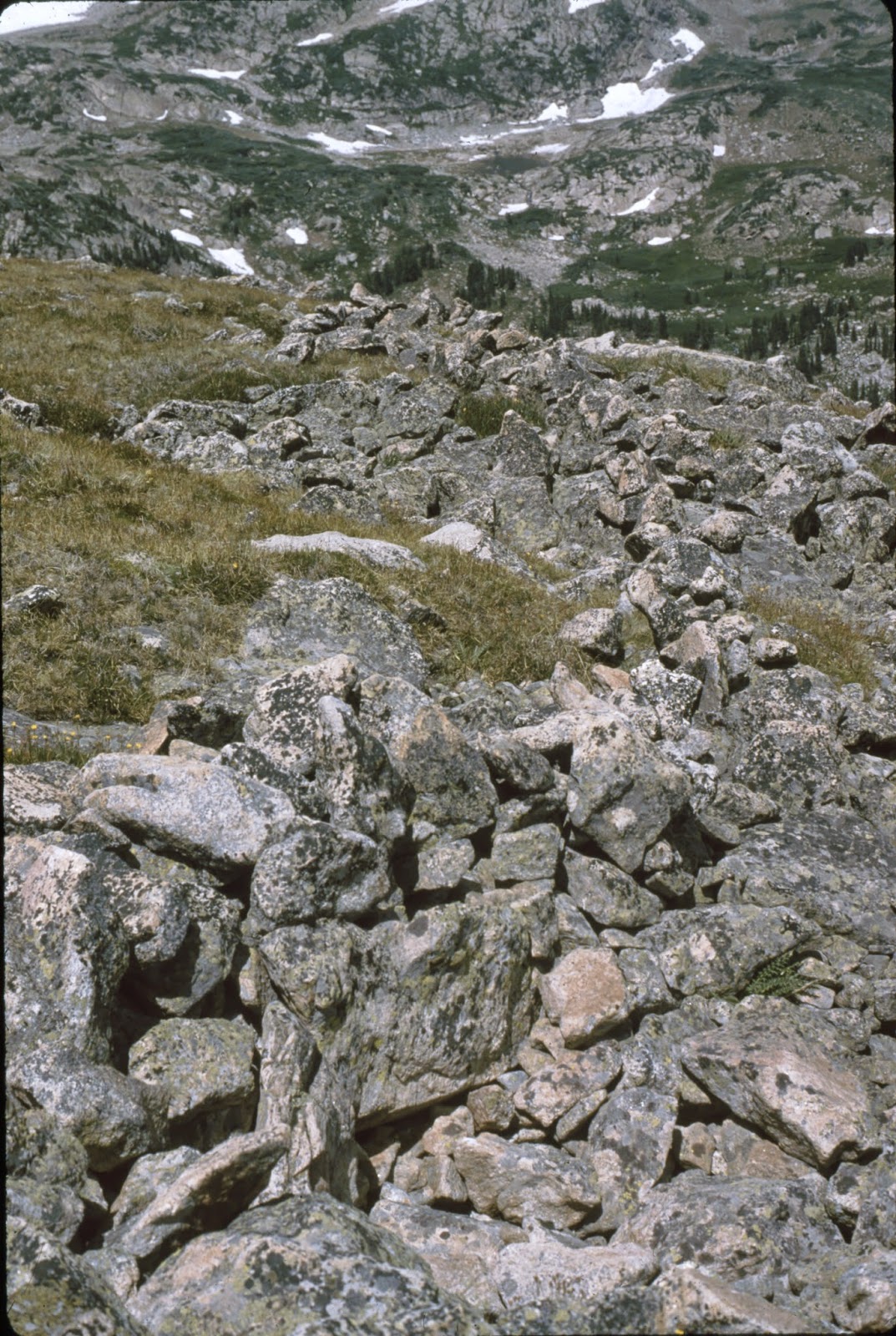Saturday, February 14, 2015
STONE BLINDS AND DRIVELINES - ROLLINS PASS, CO:
Drive line, Rollins Pass, Grand County, CO.
Photograph Peter Faris, 25 July 1987.
Over the years I have discussed features that we classify as
geoglyphs a few times. Under our western cultural classifications of art we
have always included architecture so I feel that I can properly include rock constructions
under the classification of rock art. In this posting I want to mention the
amazing rock alignments and constructions on the top of Rollins Pass in Grand
County, Colorado at 11,671’ altitude in the Colorado Rocky Mountains. I have
had the opportunity to visit there a couple of times, the first in 1987 with
Dr. James Benedict who researched high altitude archaeology for many years and
was certainly the expert on the Rollins Pass alignments.
A section of the drive line, Rollins Pass, Grand County,
CO. Photograph Peter Faris, 25 July 1987.
These comprise 12 game
drives and associated stone hunting blinds and other features. “Several drives
are small, perhaps single construction episode walls containing less than 150
meters of rock alignments, while others are large, likely aggraded drives,
which contain over 1500 meters of drive features much like other game drives in
the Indian Peaks such as Sawtooth Mountain and the Arapaho Pass System.”
(Pelton 2012:55)
Close-up of stone construction, Rollins Pass, Grand
County, CO. Photograph Peter Faris, 25 July 1987.
At the time of my first visit to the area in 1987, Dr.
Benedict gave a rough estimate of over 1 mi. of fence, 174 pit blinds, and 184
cairns, and gave his date estimates as from ca. 6,000 - 3,000 BC. Obviously
people had expended a great deal of time and energy to create these features in
the thin air of nearly 12,000 feet above sea level.
“Six of the 12 sites
contain less than 500 meters of rock alignments, three contain between 500
meters and one kilometer, two contain between one and two kilometers of rock
alignments, and one contains over two kilometers (2,041 meters) of rock
alignments. In terms of the total number of pit or hunting blind features,
seven sites contain one to ten, two sites contain 11 to 20, two contain between
30 and 40, and one contains over 40.” (Pelton 2012:55)
Photograph Peter Faris, 25 July 1987.
The hunting blinds may have been partially excavated pit
features which were then surrounded by a rock wall that the hunter could
conceal behind as the animals were driven toward them. Excavations in hunting
blinds have proven that people were indeed in them, at least on occasion, as
dropped items and tool sharpening flakes have been reported.
We can only surmise how exactly they were used, but I can
easily imagine a group of hunters gathering in some of the blinds on top of the
pass while the rest of the clan hikes down to lower altitude in the forest.
There they could spread out in a long line and begin a noisy drive up towards
the pass on top, driving any animals ahead of them and funneling them toward
where the hunters waited. In such a scenario the Rollins Pass complex would
function as sort of the reverse of a buffalo jump. In this case instead of
driving the game to fall down, they were driving them to climb up, but the
results would have been much the same.
A view of the summit of Rollins Pass and the modern road
across it seen from within one of the hunting blinds shows a section of drive
line couple of the cairns visible as longer rocks standing on end. The
landscape in the back ground gives a good idea of the altitude and the
conditions found here.
View from within a stone blind of the drive line, Rollins Pass,
Grand County, CO.photograph Peter Faris, 25 July 1987.
Cairns represented by vertical rocks in right center.
“The number of cairns
per site is most often related to a specific design element of certain game
drives - in which cairn alignments are utilized in the place of rock wall
alignments, a construction technique that requires far less labor investment
and exhibits no discernible pattern, in terms of cairn quantity, between sites.
Based on the numbers from the 12 previously recorded game drives, the “average”
game drive at Rollins Pass contains around 670 meters of rock alignments,
between 15 to 16 pit or hunting blind features, and between 9 to 10 cairns.”
(Pelton 2012:55-56)
These cairns most probably were similar to the inuksuk built
by Inuit hunters to help guide the reindeer to a desired hunting ground. How
effective could such a complex be? Dr. Benedict stated that one day during one
of his recording trips to the site he watched a deer or elk wandering up the
slope stop and divert to the side when it came to one of the drive lines, even
in there modern broken down and aggraded condition.
As rock alignments, and very impressive ones at that, these
drive line complexes certainly classify as a category of geoglyphs, and as we
consider architecture to be one component of the arts, I feel completely
justified in including these in RockArtBlog.
REFERENCE:
Pelton, Spencer R.
2012 Putting Rollins Pass on the Map:
Revitalizing the Research of a High Altitude Archaeological Landscape, pages
54-57, Colorado Archaeology, Spring
2012, Vol. 78, No. 1, Colorado Archaeological Society and Colorado Council of
Professional Archaeologists.
Subscribe to:
Post Comments (Atom)









Now that I had a chance to look around in CO, I saw many loosely defined walls. They did not need to be very substantial to steer the animals. Eg across (north) from Chatauqua Park in Boulder
ReplyDelete